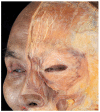Novel Anatomical Proposal for Botulinum Neurotoxin Injection Targeting Lateral Canthal Rhytids
- PMID: 35878200
- PMCID: PMC9316553
- DOI: 10.3390/toxins14070462
Novel Anatomical Proposal for Botulinum Neurotoxin Injection Targeting Lateral Canthal Rhytids
Abstract
Botulinum neurotoxin injections near the lateral canthal rhytids are commonly used in cosmetic settings; however, there is a lack of thorough anatomical knowledge, and an effective way to treat them with accumulating knowledge is needed. The anatomical characteristics concerning the injection of botulinum neurotoxin into the orbicularis oculi muscle were evaluated in this review. Current knowledge on the identification of botulinum neurotoxin injection points from recent anatomical research was assessed. The lateral canthal lines are involved with the orbicularis oculi muscle and nearby anatomical structures, and the injection points can be more precisely defined. The best possible injection sites were provided, and the injection procedure was described. This review proposes evidence for injection sites associated with the surface anatomy of the orbicularis oculi muscles to enhance the effectiveness of easing lateral canthal rhytids.
Keywords: crow’s feet; facial wrinkle; infraorbital wrinkles; injection point; orbicularis oculi muscle.
Conflict of interest statement
The authors declare no conflict of interest.
Figures








References
-
- Lee J.J., Jeon H.S., Choi H.Y. Three Cases of Esotropia after Cosmetic Botulinum Toxin A Use in the Eyelid. J. Korean Ophthalmol. Soc. 2015;56:799–802. doi: 10.3341/jkos.2015.56.5.799. - DOI
Publication types
MeSH terms
Substances
LinkOut - more resources
Full Text Sources
Medical

